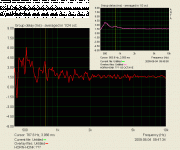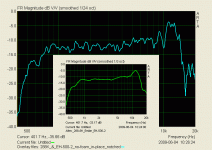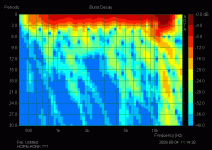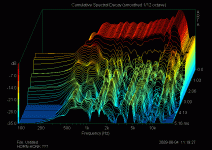Indeed. But what will the HOMs look like in a measurement? Is that buried somewhere in one of the threads?
You better be able to show graphs, cause no one will believe you if you just hear them - or not. (honk-honk)
You better be able to show graphs, cause no one will believe you if you just hear them - or not. (honk-honk)
panomaniac said:Indeed. But what will the HOMs look like in a measurement? Is that buried somewhere in one of the threads?
'Round and round we go.... 😉
Well I can't find any method published. Looked and looked. Seems no one else can, either. At one point Geddes does say he knows how to do it, but doesn't have the means.
So has it EVER been measured? Is there a measurement published? Must be somewhere. It does seem very difficult to find. Kinda puts a kink in the "how to measure."
So has it EVER been measured? Is there a measurement published? Must be somewhere. It does seem very difficult to find. Kinda puts a kink in the "how to measure."
Well I'm just piecing together the sparse resources I have read, but the impression I get regarding honk is that it comes from running too close to cutoff(one octave above seems to have been recommended) and also disappears using the LeCleac'h method to calculate the horn contour. If there is any merit to these ideas, then honk should not be considered in relation to HOM. You may now flame the newbie.
why the hostility? we do have a reference with unambigous HOM measurements in horns:
http://digital.library.adelaide.edu.au/dspace/bitstream/2440/41350/3/02chapters1-4.pdf
plots of real data ~p60+
not simple but it has been done
http://digital.library.adelaide.edu.au/dspace/bitstream/2440/41350/3/02chapters1-4.pdf
plots of real data ~p60+
not simple but it has been done
"If there is any merit to these ideas, then honk should not be considered in relation to HOM."
I don't see how you conclude the latter from the former; just because one cause of it is identified doesn't mean there aren't others.
I don't see how you conclude the latter from the former; just because one cause of it is identified doesn't mean there aren't others.
jcx said:why the hostility? we do have a reference with unambigous HOM measurements in horns:
http://digital.library.adelaide.edu.au/dspace/bitstream/2440/41350/3/02chapters1-4.pdf
I SEE 'em!
[Oh, wait, maybe not.]
Link us to the rest of the thesis, please....
- In keeping with the title of this thread, I'll ask a derivative of ( or a precursor to ) the original question ;
_________________________________________________________________________________________
How is "Horn Honk" Measured ?
- ( or what metric do you guys use to distinguish "honk" from merely poor Frequency Response ) ?
>< cheers 🙂
_________________________________________________________________________________________
How is "Horn Honk" Measured ?
- ( or what metric do you guys use to distinguish "honk" from merely poor Frequency Response ) ?
>< cheers 🙂
How is "Horn Honk" Measured ? - ( or what metric do you guys use to distinguish "honk" from merely poor Frequency Response )
"Horn honk" is a subjective phenomena which disappears as various causes of diffraction in the horn/waveguide and at its throat and mouth are eliminated.
Phenomena caused by diffraction are versions of the original driving signal (or parts of it) which arrive at the receiver delayed with respect to the original.
Geddes's study shows our sensitivity to the phenomena increases with increasing SPL. That's how "horn honk" is measured: psychoacoustically.
http://www.gedlee.com/downloads/AES06Gedlee_ll.pdf
The problem being looked at here by some is, how does one measure the delayed acoustic signals caused by diffraction.
boydon_lepasci said:Well I'm just piecing together the sparse resources I have read, but the impression I get regarding honk is that it comes from running too close to cutoff(one octave above seems to have been recommended) and also disappears using the LeCleac'h method to calculate the horn contour. If there is any merit to these ideas, then honk should not be considered in relation to HOM. You may now flame the newbie.
No flaming, Im the noob 😀
I do not understand why we care at all about HOM if its not responsible for the "Honk"
To me the whole issue is the bad sound of the horns that some people describe as the "Honk" without that bad sound waveguides/horns that cover a great deal of the horizontal and vertical planes are going to be great choices.
Furthermore, lets care about HOM audibility more instead of worrying about if it exists or not. I can assume from Geddes waveguides thread that its proven to exist but what I care about is the audibility of it.
If it is audible can we describe that sound as a "HONK"?? 😀
For me if I can eliminated the "HONK" then its a great solution, I couldnt care if HOMs existed...its all about audibility.
jcx said:http://digital.library.adelaide.edu.au/dspace/bitstream/2440/41350/3/02chapters1-4.pdf
plots of real data ~p60+
Thanks for that one!
steve71: Puns like the ones you posted can be humorous to many, even hilarious, but not appreciated by everybody, so we try to keep the threads free from ambiguity, especially when involving a person's name too. I wiped that post.

Salas said:Steve 71: Puns like the ones you posted can be humorous to many, even hilarious, but not appreciated by everybody, so we try to keep the threads free from ambiguity, especially when involving a person's name too. I wiped that post.
No worries Salas. For the record it was just meant to be a light hearted joke.
I have much respect for Dr. Geddes and his work. And for that matter I extend that respect to all who post here and I certainly wouldn't want to offend anyone.
I try to not let my better judgment get in the way of a good joke, so thanks for removing the post if you though it inappropriate for this forum. 🙂
- Here's the FR for the above pic ( which showed only group-delay ) .
- This on-axis response allows for a pretty decent sounding combo / though the "Q" of this 90 degree radial is wrong for my place ( too many early reflections / even with all the room treatment that I have in place ) .
>< cheers 🙂
- This on-axis response allows for a pretty decent sounding combo / though the "Q" of this 90 degree radial is wrong for my place ( too many early reflections / even with all the room treatment that I have in place ) .
>< cheers 🙂
Attachments
EarlK said:- Does anyone see any HONK displayed within the following Group Delay trace ?
@ 750 Hz, maybe?
noah katz said:"If there is any merit to these ideas, then honk should not be considered in relation to HOM."
I don't see how you conclude the latter from the former; just because one cause of it is identified doesn't mean there aren't others.
My understanding of the priciples I referenced led me to believe there is no "it" but rather two seperate issues. The honking seems to be handled by crossover and contour(profile?) design while HOMs as described in this thread don't honk. Obviously my knowledge is very limited, so I appreciate the guidance from members such as yourself who have at least finished an engineering degree(strong on theory) if not spent countless hours actually generating and processing data. I'm sure as this thread continues it will dispell many of my conclusions for the better.
Link to the whole paper.
Optimisation techniques for horn loaded loudspeakers.
Morgans, Richard C.
2005
http://hdl.handle.net/2440/41350
http://digital.library.adelaide.edu.au/dspace/handle/2440/41350
Optimisation techniques for horn loaded loudspeakers.
Morgans, Richard C.
2005
http://hdl.handle.net/2440/41350
http://digital.library.adelaide.edu.au/dspace/handle/2440/41350
- Status
- Not open for further replies.
- Home
- Loudspeakers
- Multi-Way
- How is HOM measured?



